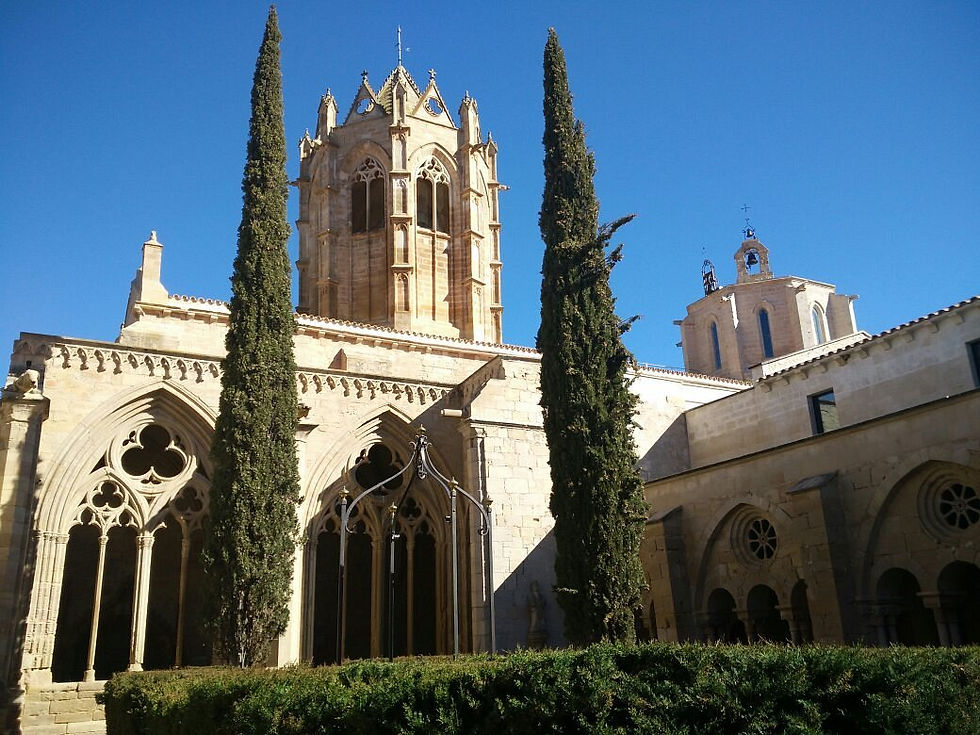Pilgrimage from Tarragona
- Hugo

- Oct 5, 2021
- 4 min read
Updated: Apr 11, 2022
The famous 'Camino de Santiago' to Santiago de Compostela also starts from Tarragona. It runs along the famous Cistercian route (Tarragona) with its three beautiful monasteries. These are also well worth visiting seperately as a day trip. Lastly in this Blog also the story of a Dutchman who deliberately walked the Camino de Santiago in the opposite direction.

The pilgrimage route to Santiago de Compostela (the 'Camino de Santiago') is the pilgrimage route to the tomb of the apostle James in Santiago de Compostela in Spain. A long journey with plenty of time for contemplation and reflection. Everyone knows the route 'Camino francés', the continuation of several routes coming from France. But there are also alternative routes, like the beautiful pilgrimage route from Tarragona. Less crowded and at least as beautiful and special.
As an enthousiast of Spain, I honestly never understood why you should first walk for the most part through France. The route from Tarragona to Santiago de Compestela is therefore ideal, 100% Spanish. The entire route from Tarragona to Santiago de Compestela is more than a thousand kilometers, can be walked in about 6 weeks, and it starts at the Camino de Tarragona, also called Camino de Sant Jaume.
Camino de Sant Jaume

The first part from the city of Tarragona, the Camino de Sant Jaume (see map above), you could walk in a week. But it is also nice to do only a part of the route, or only (part of) the Cistercian route along Tarragona's most famous three monasteries. For more practical information about the entire Camino de Santiago, I can highly recommend the Gronze website.

The Camino de Sant Jaume starts - where else? - from the cathedral of Tarragona. This route leads to Lleida in 5 stages. The first of these 5 stages is also one of the longest, no less than 36 km. Of course you can split if over different parts. Click here for the walking route of this first stage on Wikiloc. It goes all the way to the monastery of Santes Crues (see photo below). This monastery is also the start of the famous Cistercian route.

Tarragona's Cistercian Route
The Cistercian Route is the long-distance GR-175 route that connects the three Cistercian monasteries in the area: Santes Creus, Vallbona de les Monges and Poblet. These three monasteries north of Tarragona were founded in the 12th century and together form the so-called 'sacred triangle'.
With the camino from Tarragona to Santiago de Compestela you already automatically pass this route. However, many also run it as a separate tour. The Cistercian Route passes through 65 towns and villages, bringing together landscapes, gastronomy, arts and crafts, history and tradition. In addition to the three monasteries, it also takes you past the beautiful medieval village of Montblanc (see also our page with excursions from Tarragona). The pilgrim will likely do it on foot, but you can also do it easily by mountain bike. If you want to walk this route (La Ruta del Cister) in a loop with start and end point at Poblet, and therefore not as part of the Camino de Compestela, it is about 105 km. Click here for the link to the hiking route of GR-175 La Ruta del Cister on Wikiloc in 5 stages and here for the route by mountain bike.
If you don't have the time (or energy) to do the entire route on foot or by bike: each of the monasteries are also easy to reach by car and fun to visit.
See a short video below with an impression of La Ruta del Cister.

The Monastery of Santes Creus is a former Cistercian abbey in the town of Aiguamúrcia (Tarragona) and the only one of the three monasteries that is no longer inhabited by monks. This gives visitors the opportunity to view areas that are normally not open to the public. More to the north is the monastery of Vallbona de les Monges (see photo), where a community of nuns still lives today. But the most beautiful of the three monasteries is Poblet (see photo below). This monastery was built in the 12th century and is included in the UNESCO World Heritage List. It is surrounded by 14th century walls. Highlights of Poblet are the Gothic cloisters, the tombs of several Spanish monarchs (including Jaume I) and the chapel of San Jorge.

The Camino in reverse
Regardless of where the pilgrimage begins, or how long it takes you, it is ultimately about your own contemplation and reflection during the journey. In the past the motive to walk the Camino was mostly religious, nowadays many motives have been added, such as cultural-historical, sportive or to enjoy the landscape and nature. Also, being far away from our hectic daily worries, most pilgrims make the journey to clear their heads, bringing everything in to perspective again, looking backwards and forwards.

The Dutch author Herman Vuijsje goes one step further.
In his book “Pilgrim without God” he describes his hike from Santiago de Compostela to Amsterdam. He chose to make the journey alone and in the opposite direction or, as he puts it himself, from Catholic Spain to godless Amsterdam. More than a travel diary, it is also a journey through the European history of ideas and a search for anchors for morality and spirituality in this world where church and tradition seem to be disappearing.
When he describes how in the past pilgrims made the journey to avoid purgatory, he says: “I think the Camino is purgatory itself. You suffer, you have to fight against yourself, you sweat, you are fried, you are in pain. You are purified: the purgatorio”.
Regardless where, with what motive or for how long: wishing you lots of inspiration and reflection from beautiful Tarragona!




Comments